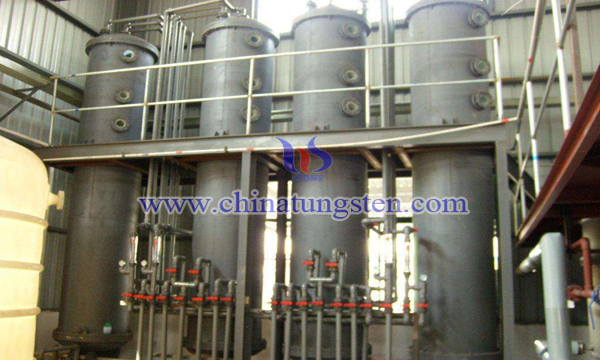Tungsten Rhenium Removal by Ion Exchange
- Details
- Category: Tungsten Information
- Published on Monday, 05 November 2018 23:37
With the development and wide application of high performance tungsten materials, the influence of impurity element content on the properties of tungsten materials and tungsten alloys has been gradually recognized. The requirement of purity or some impurity content of ammonium paratungstate in various industrial fields will be higher and higher.

APT in China is currently manufactured according to the national standard grade 0. Even if it is calculated according to the upper limit of 23 impurity elements contained in the standard, its purity is only about 99.9%, and its standard does not require rhenium content. As a rare high melting point metal with similar properties to tungsten and molybdenum, rhenium is often associated with molybdenum ores. At present, the molybdenum content in tungsten ores is getting higher and higher. At the same time, the national standard of tungsten products does not require rhenium content. Lack of attention to rhenium in the production process of tungsten products may lead to rhenium entering the final product. Tungsten products may not be able to meet the higher requirements of some materials for trace elements.
At present, the separation methods of tungsten and rhenium are mainly ion exchange, volatilization and potassium ferrate precipitation. The removal of rhenium from ammonium parotungstate was carried out by ion exchange method. The purification method is simple and controllable. Dynamic ion exchange adsorption with Cl-type 201*7 resin can maximize the use of high concentration WO42-to replace the adsorbed impurity anion ReO42-, thus achieving the effect of rhenium removal, controlling the crystallization rate of ammonium paratungstate to be less than 80%, and obtaining high purity of rhenium content less than 5 ppm. Ammonium parotungstate is operated as follows:
Step 1: Dissolution: Take 57 g sodium hydroxide (analytical purity) and dissolve in 4.425 L water to obtain sodium hydroxide solution, then dissolve 100 g rhenium content of 18 ppm ammonium paratungstate in sodium hydroxide solution, react with sodium hydroxide, and finally get sodium tungstate alkali solution; the mass concentration of NaOH in sodium tungstate alkali solution is 6 G. The mass concentration of /L and WO3 is 20g/L.
Step 2: Adsorption: The alkali solution of sodium tungstate described in step 1 is ion exchanged dynamically through an ion exchange column filled with Cl-type 201*7 resin. When the mass concentration of WO3 in the effluent of the ion exchange column is the same as that in the inflow, the adsorption of Cl-type 201*7 resin is saturated and the ion exchange station is stopped. The exchange rate of sodium tungstate alkali solution in ion exchange process is 4 cm/min, and the temperature of sodium tungstate alkali solution in dynamic ion exchange process is 25 ℃.
Step 3: Desorption: After the end of the ion exchange adsorption process in step 2, Cl-201*7 resin in the ion exchange column was eluted with 10g/L NH4Cl+1mol/L NH3*H2O solution, and then the Cl-201*7 resin in the ion exchange column was desorbed with 5mol/L NH4Cl+2mol/L NH3*H2O solution to obtain a pure ammonium tungstate solution.
Step 4. Crystallization: Ammonium paratungstate crystals with rhenium content of 5 ppm were obtained by evaporating the pure ammonium tungstate solution desorbed in step 3 at 95 ℃. When the crystallization rate of ammonium paratungstate was 80%.
The method mentioned above can purify and remove rhenium from ammonium paratungstate to obtain higher purity ammonium paratungstate, thus satisfying the requirement of low rhenium content in tungsten for some special materials and realizing the purification of ammonium paratungstate containing trace rhenium.
- Tungsten Oxide Manufacturer & Supplier, Chinatungsten Online: www.tungsten-oxide.com
- Tungsten News & Prices of China Tungsten Industry Association: www.ctia.com.cn
- Molybdenum News & Price: news.molybdenum.com.cn
- Tel.: 86 592 5129696; Fax: 86 592 5129797; Email: sales@chinatungsten.com



 sales@chinatungsten.com
sales@chinatungsten.com